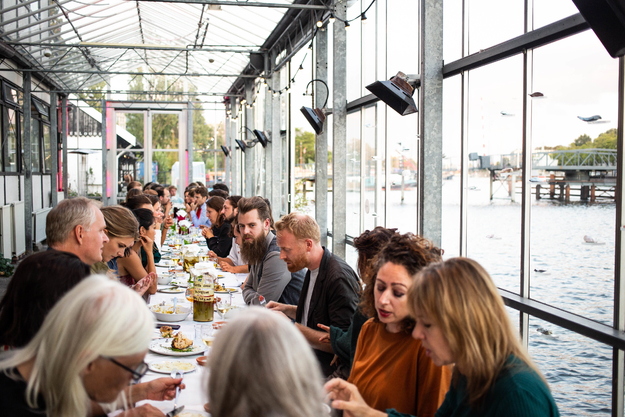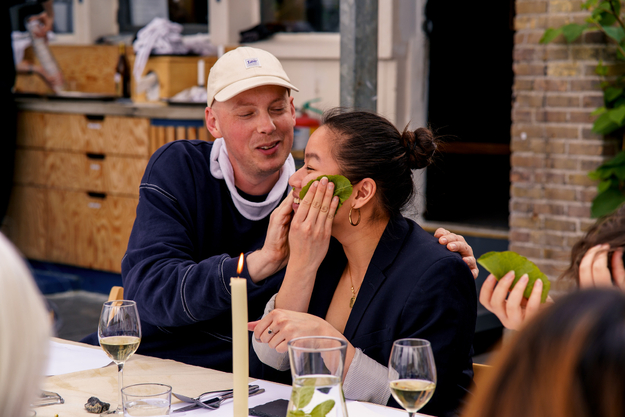The intricate dynamics of food sharing are significant in human interaction and societal bonding. Food sharing is deeply ingrained in human culture and has evolved beyond its primal purpose of fuelling us. It serves as a tool for social interaction, communication, and the cultivation of relationships. By understanding the performative nature of food sharing, and how this is done in various ways, we can gain insights into human behaviour, cultural norms, and the dynamics of social gatherings.
The Neo Futurist Dinner (NFD) series, put on periodically by Mediamatic, are interactive dining experiences. In these dinners, artists and chefs are invited to use food and its surrounding rituals as a medium to speak about society, culture, ecology and their collective future. These events explore how food, art, politics, and science are intertwined, combining food, art, and science into a singular, immersive experience. Instead of following conventional menu structures, the dinners are created by a combination of chefs, artists, and designers. These creative minds approach the event with their unique interpretations, rooted in a contemporary understanding of food and its intricate cultural connotations. There is also an emphasis on the five senses, using the tactile, smell, and auditory dimensions of the culinary journey. Beyond gastronomy, the NFDs serve as a platform to bring awareness on world issues such as urgent ecological concerns and innovative food-related perspectives.
Beyond gastronomy, the NFDs serve as a platform to bring awareness on world issues such as urgent ecological concerns and innovative food-related perspectives.
In the NFDs, guests are encouraged and expected to be a part of the experience, sometimes bordering on the uncomfortable. The dining experience created through the NFDs at Mediamatic aim to challenge people’s usual expectations of dining, pushing them beyond what they usually do. This transforms the dining experience into an event that goes further than just eating. Dinners like this also explore the concept of being present. Guest participation is an important component, adding to the way that these dinners stray from traditional dining experiences.
In a Neo Futurist Dinner the food itself becomes a form of performative art. This happens through the beautiful and intricate ways that the various courses are presented, but also through the ways that the food is interacted with and conceptualised. This could be spelling it, feeling it, peeling it, or rubbing it on your skin. All of the ingredients become actors that play out a relationship with one another. Specific ingredients are added or left out in order to add meaning to the dish. Eating requires also partaking in a scene, with performance art enhancing the sensory perception. One of the aims is to evoke memories and emotions through the use of taste, other senses, and active participation.
This could be spelling it, feeling it, peeling it, or rubbing it on your skin.
One of the aims is to evoke memories and emotions through the use of taste, other senses, and active participation. Challenged in their habits and expectations, participants go through an embodied experience that hopes to leave them with new and valuable insights.
One of the features of the Neo Futurist Dinner series is to highlight the idea of communal food sharing. Each dinner brings together a new group of people and invites them to sit all together at a long table, family style. While the goal of the dinner is to encourage participants to think about the food they consume in a new way, the community element is also a key feature. Dinner guests are given the opportunity and encouraged to sit among people that they do not already know. It is not often that we are given the opportunity to sit, dine, and converse with strangers. Going through this experience it somehow becomes natural t0 discuss with one another the various elements of the dinner and perhaps dig deeper into your shared experience.
Despite the fact that you are dining with people who you may never meet again, there is a sense of community that is nurtured through this experience. Eating is an intimate activity. So to share this experience with strangers in such close proximity can feel vulnerable. In addition, you may even be asked to interact with the strangers next to you, holding their hand or another kind of more intimate, personal action. This creates an unavoidable bond between people.
Despite the fact that you are dining with people who you may never meet again, there is a sense of community that is nurtured through this experience.
Eating out at restaurants is typically viewed as a social activity governed by familiar norms and customs. Restaurants are structured environments where people expect a certain level of order and predictability, primarily focused on the enjoyment of food. While some restaurants may attempt to disrupt these expectations with innovative designs or experiences like dining in the dark, it's uncommon for dining out to become a full-blown performance. The idea of guests actively participating as actors in an unfamiliar script is even rarer, as most patrons simply anticipate a pleasant meal without intense emotional engagement, unless it's a significant occasion like a first date, equally performative, unpredictable, and emotionally engaging. However, there is an increasingly popular trend of creating unique dining experiences that include more than what is typically involved in eating out.
Food sharing has always been an important part of human interactions and is often tied up with cultural rituals and traditions. Sharing food with others helps with the maintenance of social relationships. We often use grabbing a meal or a drink as an excuse to catch up with friends, meet new people, or network. In many communities, sharing food is also an act of showing love, celebration, and welcoming people in. I am sure we can all think of a case where we have been at a social event and there is more food offered than could possibly be eaten and there is that one person encouraging everyone to keep eating and try everything there is to offer. Everyone is aware of this dynamic but goes along with it, understanding that the gestures are about more than the food itself. What is important is the memories that are being made around the food.
What is important is the memories that are being made around the food.
Food sharing breaks past the utilitarian function of eating, allowing food to become a space for social interaction, communication, and cultural expression. By recognizing the performative dimensions of this basic human activity, we can appreciate the role it plays in shaping our relationships, identities, and shared experiences. By understanding eating as an event rather than something just to satisfy your hunger, it becomes a place where people share the table. It's a place where people can have a moment with each other or to listen to something or to conceive an idea. The aim is to make those around the table think about something new and maybe even change the way they look at the world. That could be about invasive species, thinking about who is welcomed and who is not, or it could be about other controversial topics such as ecological dread or migration. Either way, food sharing is about much more than what is on the plates.
Sources:
“Food Sharing.” Anthroholic. Accessed May 11, 2024. https://www.tandfonline.com/doi/full/10.1080/17535069.2020.1737726.
Pløger, John. “Dining out as a Performative Event.” Urban Research & Practice 15, no. 1 (2022): 94–111.
“The Rituals of Sharing Food.” FasterCapital. Accessed May 11, 2024. https://fastercapital.com/topics/the-rituals-of-sharing-food.html#:~:text=The%20etiquette%20of%20sharing%20food,everyone%20feels%20comfortable%20and%20included.


